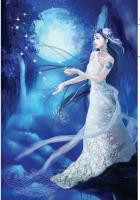The eyes of all children are bluish immediately after birth; later on they change to the colour which is to be theirs permanently.But in the case of other animals this is not visible.The reason of this is that the eyes of other animals are more apt to have only one colour for each kind of animal; e.g.cattle are dark-eyed, the eye of all sheep is pale, of others again the whole kind is blue or grey-eyed, and some are yellow (goat-eyed), as the majority of goats themselves, whereas the eyes of men happen to be of many colours, for they are blue or grey or dark in some cases and yellow in others.Hence, as the individuals in other kinds of animals do not differ from one another in the colour, so neither do they differ from themselves, for they are not of a nature to have more than one colour.Of the other animals the horse has the greatest variety of colour in the eye, for some of them are actually heteroglaucous;this phenomenon is not to be seen in any of the other animals, but man is sometimes heteroglaucous.
Why then is it that there is no visible change in the other animals if we compare their condition when newly born with their condition at a more advanced age, but that there is such a change in children? We must consider just this to be a sufficient cause, that the part concerned has only one colour in the former but several colours in the latter.And the reason why the eyes of infants are bluish and have no other colour is that the parts are weaker in the newly born and blueness is a sort of weakness.
We must also gain a general notion about the difference in eyes, for what reason some are blue, some grey, some yellow, and some dark.To suppose that the blue are fiery, as Empedocles says, while the dark have more water than fire in them, and that this is why the former, the blue, have not keen sight by day, viz.owing to deficiency of water in their composition, and the latter are in like condition by night, viz.owing to deficiency of fire- this is not well said if indeed we are to assume sight to be connected with water, not fire, in all cases.Moreover it is possible to render another account of the cause of the colours, but if indeed the fact is as was stated before in the treatise on the senses, and still earlier than that in the investigations concerning soul- if this sense organ is composed of water and if we were right in saying for what reason it is composed of water and not of air or fire- then we must assume the water to be the cause of the colours mentioned.For some eyes have too much liquid to be adapted to the movement, others have too little, others the due amount.Those eyes therefore in which there is much liquid are dark because much liquid is not transparent, those which have little are blue; (so we find in the sea that the transparent part of it appears light blue, the less transparent watery, and the unfathomable water is dark or deep-blue on account of its depth).
When we come to the eyes between these, they differ only in degree.
We must suppose the same cause also to be responsible for the fact that blue eyes are not keen-sighted by day nor dark eyes by night.
Blue eyes, because there is little liquid in them, are too much moved by the light and by visible objects in respect of their liquidity as well as their transparency, but sight is the movement of this part in so far as it is transparent, not in so far as it is liquid.Dark eyes are less moved because of the quantity of liquid in them.And so they see less well in the dusk, for the nocturnal light is weak; at the same time also liquid is in general hard to move in the night.But if the eye is to see, it must neither not be moved at all nor yet more than in so far as it is transparent, for the stronger movement drives out the weaker.Hence it is that on changing from strong colours, or on going out of the sun into the dark, men cannot see, for the motion already existing in the eye, being strong, stops that from outside, and in general neither a strong nor a weak sight can see bright things because the liquid is acted upon and moved too much.















